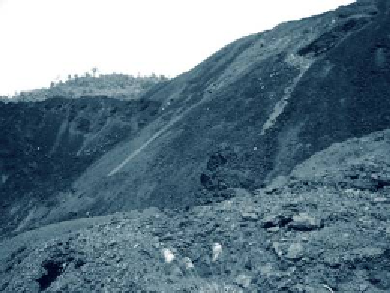Environmental Engineering Reference
In-Depth Information
TABLE 6.6
Laboratory Leaching Test Methods -
A far too common approach is to classify a material based only on the chemical assays. The appropriate approach for
assessing environmental characteristics of solid materials is by laboratory leaching testing
Type of Leaching Test
Test Standard
Column-leaching test
(EN 14405)
Two-stage agitated leaching test
(EN 12457-3)
Availability-leaching test
(NT Envir 003)
Oxidized availability leaching test
(NT Envir 006)
pH-static leaching test
(CEN/TC 292/WG6)
The US EPA Toxicity Characteristic Leaching Procedure (TCLP)
Test method 1311
how metals are bound in the matrix. The appropriate approach for assessing environmental
characteristics of slag is in form of laboratory leach testing. A variety of factors influence the
leaching characteristics of different elements. A variety of different standard tests are used
to characterize the leaching properties of a material (
Table 6.6
).
Column tests and two-stage serial batch tests are frequently used for the characteriza-
tion of by-products, including materials to be characterized before land filling. A leachate
test predicts whether a material is likely to leach contaminants, specifically metals, at levels
of concern. The material is subjected to an extraction fluid (e.g. a basic or buffered solu-
tion) and then the resulting extract is analyzed and compared to a leachate criteria list. If the
resulting concentration is equal to or in excess of the concentration specified for that con-
taminant in the applicable schedules, the material is considered leachate toxic and may be
considered potentially toxic or hazardous. In addition, the material may require treatment
to eliminate or reduce the leaching potential prior to disposal or may require disposal in a
secure, hazardous waste landfill.
The second main category of solid waste streams originates from air pollution controls
(e.g. gypsum from scrubbers) and water treatment facilities. These wastes are usually haz-
ardous and in the form of sludge. Final disposal is difficult and generally costly. Modern
smelting technologies aim to reduce gaseous and solid waste emissions. Wastes destined for
disposal from metal production are kept to a minimum. Flue dusts are typically recycled to
A leachate test predicts whether
a material is likely to leach
contaminants, specifi cally metals,
at levels of concern.
CASE 6.6
Slag Disposal into the Environment - An Environmental
Eyesore or Reason for Concern?
The nickel mining and smelting operation of INCO in
Sulawesi, Indonesia commenced about four decades ago and
has been in operation since then. The ferro-nickel smelter
produces slag at a rate of several tons per hour, which is
dumped at valleys nearby the smelter. While leachate test-
ing indicates that the slag is inert, the practice continually
invites mine opponents to criticize the mining
operation in general and the slag disposal
practice in particular. Claims continue to
be made that leachate from slag disposal
sites cause environmental damage to
groundwater and surface water runoff.










Search WWH ::

Custom Search